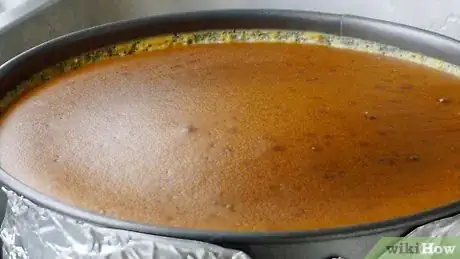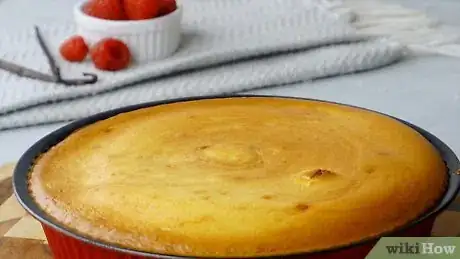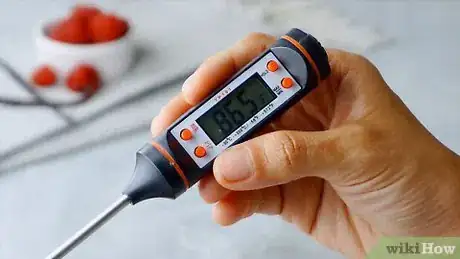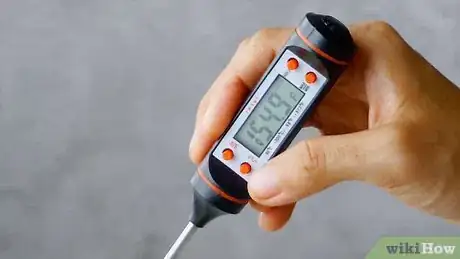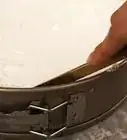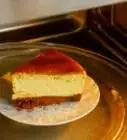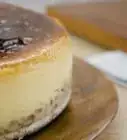This article was co-authored by Maria Short and by wikiHow staff writer, Sophia Latorre. Maria Short is a Baker and the Owner of Short N Sweet Bakery & Cafe in Hilo, Hawaii. With over 24 years of experience, she specializes in specialty desserts and wedding cakes. She graduated from L’Academie de Cuisine’s Pastry Arts Program with honors and studied at Baltimore International Culinary College. In 2019, Maria competed in the 6th season of the Food Network’s Holiday Baking Championship. In 2010, she had a cake named one of “America’s Most Beautiful Cakes” by Brides magazine.
There are 9 references cited in this article, which can be found at the bottom of the page.
wikiHow marks an article as reader-approved once it receives enough positive feedback. In this case, several readers have written to tell us that this article was helpful to them, earning it our reader-approved status.
This article has been viewed 304,090 times.
Cheesecake, whether you like New York or Italian style, is a light and delicious dessert. Because it contains a fair amount of milk or cream in addition to soft cheese, it can be hard to tell when it is done. However, there are several things you can do to determine if your cheesecake is ready, such as testing the temperature, gently shaking the pan, and touching the surface of the cake.
Steps
Shaking the Cake
-
1Shake the cheesecake pan gently. While the cheesecake is still in the oven, use an oven mitt to gently shake the pan. Don’t be too rough with your still-warm dessert or it may crack. Simply jiggle the pan a small amount. Take care not to get water in the pan if you have baked your cheesecake using a water bath.[1]
-
2Check to see how much the center jiggles. When you shake the pan and a 2 in (5.1 cm) area in the center jiggles slightly, the cheesecake is done. If there is a large, jiggly area, or if liquid breaks the surface or sloshes over the edges of the pan, the cheesecake is not finished cooking. Bake the cheesecake for another 5 minutes or so before checking it again for doneness.Advertisement
-
3Expect sour cream filling to jiggle more than cream cheese filling. If you used a fair amount of sour cream in your cheesecake, it will jiggle more than a cake that is filled primarily with cream cheese or ricotta. There will be a large soft spot in the center, so look for slightly brown, puffed-up edges to indicate when the cheesecake is done. Keep in mind, also, that the center will continue cook and firm up slightly as the cheesecake cools.[2]
- If you continue cooking the cheesecake until the center is firm and doesn’t jiggle it will be baked for too long.
Touching the Surface
-
1Wash and dry your hands. Before touching the cheesecake, thoroughly wash your hands with warm water and soap. Rinse your hands to remove the soap residue and dry them completely.
-
2Use 1 finger to touch the center of the cheesecake. Gently touch the surface of the center of the cheesecake with 1 or 2 fingers. Don’t press too hard! You want to check the doneness in the middle of the cake, rather than near the edges.[3]
-
3Look for a firm surface. If the surface of the cheesecake has a little bit of give but feels firm, the cake is done. If your finger sinks into the cake or comes away with batter on it, the cake needs more time in the oven. Bake it for another 5 minutes before checking it again.[4]
Looking at the Cake
-
1Check for a little bit of puffing and browning at the edges. You can tell a cheesecake is done when a 1⁄2 inch (1.3 cm) ring around the the edge begins to brown and puff up slightly from the pan. The filling should still be pale, rather than golden. Don’t allow it to continue cooking, or it can end up over baked.[5]
-
2Look for firmness around the edges of the filling. If the edges are liquid, rather than set and firm, your cheesecake isn’t done yet. Only the middle 2 inches (5 cm) should still be jiggly rather than firm when your cheesecake is perfectly baked.[6]
-
3Take it out when the surface is no longer shiny. Once the surface of the cheesecake is no longer shiny, it’s done! Make sure the entire cake, including the soft center, have lost their shine before removing the cake from the oven.[7]
- Some bakers prefer to let the cheesecake cool in the oven. Turn off the heat and let the cake sit in the oven with the door cracked about 1 inch (2.5 cm) for 1 hour. At that point, take the pan out of the oven, remove the springform pan from the water bath (if applicable), and let the cheesecake cool completely before taking it out of the springform pan.[8]
Checking the Temperature
-
1Obtain an instant-read cooking thermometer. You don’t want to have to wait several minutes while the thermometer determines the temperature, so choose an instant-read variety. Make sure it gets cleaned after each use.[9]
- You should occasionally calibrate your thermometer to be sure it gives an accurate reading. To do so, fill a small pan with water and bring it to a rolling boil. Take the water’s temperature—it should be 212 °F (100 °C).[10]
- Turn the hex bolt at the bottom of an analog thermometer to calibrate the temperature if it is incorrect. Consult the manufacturer’s directions to calibrate a digital thermometer.[11]
-
2Test the temperature in the middle of the cake. The edges may be warmer than the center, so to know if your cake is done, you’ll need to test the temperature in the middle. Don’t push the thermometer down to the bottom of the pan, simply stick it halfway through the cake.[12]
- Keep in mind that sticking a thermometer in the cheesecake may cause it to crack, so try to only test the temperature once, rather than multiple times. If you must test it more than once, stick the thermometer in the same hole you used the first time to minimize cracking.[13]
-
3Look for a reading of 150 °F (66 °C). Once the center of the cheesecake reaches 150 °F (66 °C), the cake is done! Take it out of the oven and allow it to cool completely on a wire rack. If it is not yet done, put it back in the oven for about 5 minutes, then check it again to see if it is done. Repeat until you get a reading of 150 °F (66 °C).[14]
- Chill the cheesecake before you remove it from the pan.
- If it is not completely chilled, it may stick or crack.
Community Q&A
-
QuestionI don't feel comfortable doing the warm bath and foil around the pan. Will the other steps and ideas work without doing that?
 The Hungry BitesCommunity AnswerYes, you can test if a cheesecake is done with the above methods even if you don't use the waterbath method. The waterbath helps the cheesecake to bake more evenly, since it prevents the edges from cooking too fast and the center remaining uncooked.
The Hungry BitesCommunity AnswerYes, you can test if a cheesecake is done with the above methods even if you don't use the waterbath method. The waterbath helps the cheesecake to bake more evenly, since it prevents the edges from cooking too fast and the center remaining uncooked. -
QuestionHow do I know when a cheesecake is done if it's a no bake, set in the fridge cake?
 Rachel Lyon-StudentCommunity AnswerDepending on the type of cheesecake, usually it is fine to take out if it has developed a skin, and is firm in the middle. It is hard to over-sit a fridge cheesecake. I'd say give it a few hours.
Rachel Lyon-StudentCommunity AnswerDepending on the type of cheesecake, usually it is fine to take out if it has developed a skin, and is firm in the middle. It is hard to over-sit a fridge cheesecake. I'd say give it a few hours. -
QuestionWhen freezing the cheesecake, do I freeze it in or out of the spring form pan?
 RebekahCommunity AnswerFreeze the cheesecake in the spring form pan.
RebekahCommunity AnswerFreeze the cheesecake in the spring form pan.
Warnings
- Don’t test a cheesecake’s doneness by poking it with a toothpick or knife. It won’t give you an accurate assessment and can also create a crack in the filling.[16]⧼thumbs_response⧽
References
- ↑ http://www.bhg.com/recipes/how-to/bake/what-is-the-best-way-to-check-if-a-baked-cheesecake-is-done/
- ↑ http://www.bhg.com/recipes/how-to/bake/what-is-the-best-way-to-check-if-a-baked-cheesecake-is-done/
- ↑ http://www.pastrywiz.com/dailyrecipes/recipes/598.htm
- ↑ http://www.pastrywiz.com/dailyrecipes/recipes/598.htm
- ↑ http://www.bonappetit.com/test-kitchen/common-mistakes/article/cheesecake-common-mistakes
- ↑ http://thebakingpan.com/cheesecake-hints-and-tips/
- ↑ https://www.rockrecipes.com/how-to-bake-the-perfect-cheesecake-every-time/
- ↑ https://www.thekitchn.com/how-to-make-perfect-cheesecake-recipe-cooking-lessons-from-the-kitchen-110760
- ↑ https://whatscookingamerica.net/Cake/cheesecaketip.htm
- ↑ http://www.finecooking.com/article/calibrate-your-instant-read-thermometer
- ↑ http://www.finecooking.com/article/calibrate-your-instant-read-thermometer
- ↑ https://whatscookingamerica.net/Cake/cheesecaketip.htm
- ↑ https://www.craftybaking.com/howto/baking-test-doneness
- ↑ https://whatscookingamerica.net/Cake/cheesecaketip.htm
- ↑ http://thebakingpan.com/cheesecake-hints-and-tips/
- ↑ http://www.bhg.com/recipes/how-to/bake/what-is-the-best-way-to-check-if-a-baked-cheesecake-is-done/
About This Article
To tell if a cheesecake is done, insert an instant-read cooking thermometer halfway into the center of the cake. Take the cheesecake out of the oven when the center reaches 150 °F. If you don’t have a cooking thermometer, use an oven mitt and gently shake the cheesecake pan while it’s still in the oven. When the cheesecake is finished cooking, only a 2 inch area in the center of the cake will jiggle slightly, although a sour cream cheesecake will jiggle more than one made with primarily cream cheese or ricotta. For more tips from our Baker reviewer, including how to tell if a cheesecake is done just by looking at it, read on!
